#postminimal art movement
Explore tagged Tumblr posts
Text
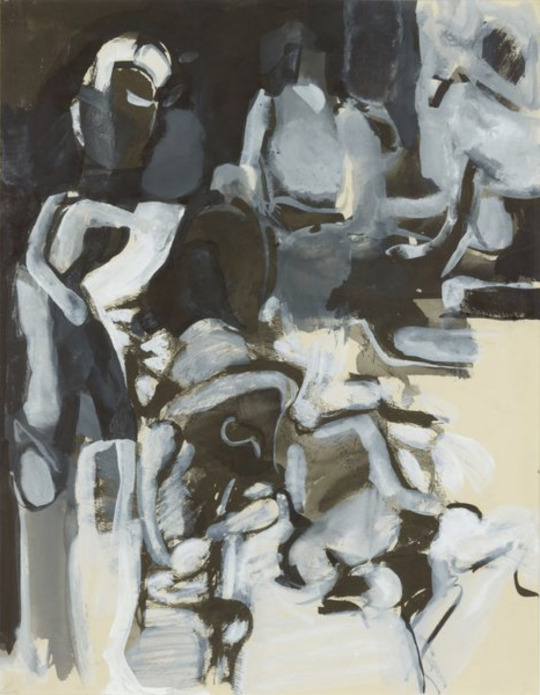
Eva Hesse (American 1936-1970), Untitled, 1960. Gouache and India ink on paper, 34.6 x 26.8 cm. | 13 5/8 x 10 1/2 in.
#art#artwork#modern art#contemporary art#modern artwork#contemporary artwork#20th century modern art#20th century contemporary art#American art#modern American art#contemporary American art#minimalism#postminimalism#postminimal art movement#female artist#female painter#woman artist#woman painter#female American artist#female American painter#Eva Hesse
6 notes
·
View notes
Text




"The way to beat discrimination in art is by art. Excellence has no sex." #EvaHesse
#bornonthisday Eva Hesse (January 11, 1936 – May 29, 1970) was a German-born American sculptor known for her pioneering work in materials such as latex, fiberglass, and plastics. She is one of the artists who ushered in the postminimal art movement in the 1960s. via Wikipedia
Eva Hesse (DE|USA, 1936-1970), Accession IV, 1968, Galvanized steel and rubber tubing, 8 1/8 x 8 x 8 1/4 inches (20.6 x 20.3 x 21 cm)
#EvaHesse #arthasnosex #GermanArtist #GermanFemaleArtist #feministart #artbywomen #womeninarts #postminimalism #minimalism #sculpture #femalesculptor
1 note
·
View note
Photo

Contingent, 1969, Eva Hesse
“Eight large sheets form a translucent and irregular skin-like sculpture that hangs from the ceiling. The frailty of these thin objects, which bend under their own weight as they graze the floor, is characteristic of much of the artist’s work, which acknowledges the role of tragedy in her life.” - The Art Museum, Phaidon
#Contigent#Eva Hesse#Hesse#sculpture#installation#art installation#artwork#arty#artsy#art of the day#art daily#daily art#inspiration#inspirational#sculptor#postminimal art movement#process art#post minimal#postminimal#contemporary art#art contemporain
10 notes
·
View notes
Photo

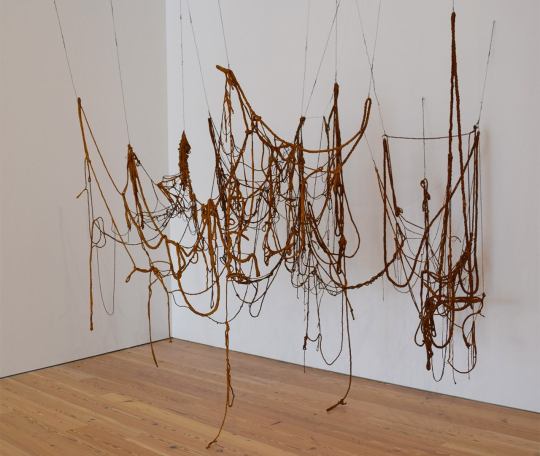
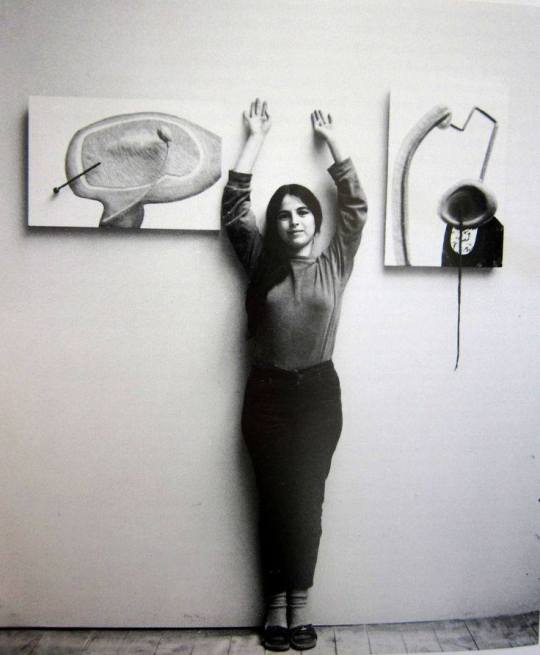
Eva Hesse (1936 – 1970), was a Jewish German-born American sculptor, known for her pioneering work in materials such as latex, fiberglass, and plastics. She is one of the artists who ushered in the postminimal art movement in the 1960s.Hesse was born into a family of observant Jews in Hamburg.
When Hesse was two years old in December 1938, her parents, hoping to flee from Nazi Germany, sent Hesse and her older sister, Helen Hesse Charash, to the Netherlands via Kindertransport.
After almost six months of separation, the reunited family moved to England and then, in 1939, emigrated to New York City, where they settled into Manhattan's Washington Heights. In 1944, Hesse's parents separated; her father remarried in 1945 and her mother committed suicide in 1946.
In 1969, she was diagnosed with a brain tumor, and she died in 1970, at the age of 34.
Her art is often viewed in light of all the painful struggles of her life including escaping the Nazis, her parents' divorce, the suicide of her mother when she was 10, her failed marriage, and the death of her father. While experiences no doubt had profound impressions on Hesse, the true impact of her artwork is in her inventive uses of material, her incredibly contemporary response to the minimalist movement, and her ability to usher in the postmodern and postminimalist art movements.
Danto describes her as "cop[ing] with emotional chaos by reinventing sculpture through aesthetic insubordination, playing with worthless material amid the industrial ruins of a defeated nation that, only two decades earlier, would have murdered her without a second thought."
In 2016, a documentary titled Eva Hesse, premiered in New York directed by Marcie Begleiter. (mostly from wikipedia)
14 notes
·
View notes
Text
Artist Research- Eva Hesse
Eva Hesse (1936-1970) was an American sculptor, born in Germany. Hesse was known for her sculptural work with materials such as plastics, fiberglass and latex. Hesse was a key figure in the postminimal art movement in the 1960s. I am most interested in her work with rope and latex, creating sprawling web-like shapes.
Untitled (1969-1970)
https://whitney.org/collection/works/5551
This is the one piece in Hesse’s catalogue of work that I find myself the most drawn to. The suspended rope, draped in latex, creates a sense of movement in my mind, a stretching, reaching and spreading. This piece seems like it’s full of life, exuberant and almost whimsical? Most of all I like that this piece seems to scream ‘fun.’ I would like to achieve a similar sense of life within my sculptural experiments.

Connection (1969)
https://www.tate.org.uk/research/publications/tate-papers/08/thoughts-on-replication-and-the-work-of-eva-hesse
The hanging nature of this piece reminds me of a dreamcatcher that I used to have hanging over my bed. The linear quality of it draws my eye up and down the piece, and I can imagine it swaying in the wind. I think this creates a sense of movement. I am also intrigued by the suggestion of weight in the piece, are the strings cast in latex heavy? The contrast between the thin, weightless string and the thick latex is interesting. The idea of recreating a similar experiment with candle wax is interesting to me.

Ennead (1996)
https://www.icaboston.org/art/eva-hesse/ennead
This piece is really interesting to me because of the sense of drag, the strings seem to be dragging themselves towards the opposite wall and onto the floor. In contrast the previous piece, ‘Ennead’ seems almost lifeless, like the energy was sucked out of it, as it hangs limply above the ground. I do find that the tangled string is a very interesting texture and I would like to experiment further with that.

Contingent (1969)
https://www.tate.org.uk/research/publications/tate-papers/08/thoughts-on-replication-and-the-work-of-eva-hesse
This piece is an example of the variety in Hesse’s work. While it doesn’t interest me in the same way that the rope and string sculptures do, there’s no denying that this piece is captivating, the contrast in materials alone was enough to interest me.

Untitled or Not Yet (1966)
https://www.artsy.net/article/artsy-editorial-eva-hesse-artist
This piece by Hesse is particularly interesting to me as I had an idea very similar to this shortly before seeing this image. The sense of downward pressure, the gravity pulling on the structure is really interesting to me. The idea I had was to place jelly inside of the net from a bag of oranges, and observe if gravity would make the jelly seep out, or keep it contained. Hesse’s work is obviously far more sophisticated than my first year student experiments, but having this image as a reference and inspiration is comforting.

5 notes
·
View notes
Photo

Robert Morris - Conceptual Art Robert Morris (1931 - 2018 )was an American sculptor, conceptual artist and writer. He was regarded as having been one of the most prominent theorists of Minimalism along with Donald Judd but he also made important contributions to the development of performance art, land art, the Process Art movement, and installation art. #art #artist #americanart #americanartists #artistic #fineart #contemparyart #visualart #visualculture #conceptualart #sculpture #installation #installationart #minimalism #minimalismart #minimalistsculpture #postminimalism #culture #blog #artblog @expositionblog https://www.instagram.com/p/CNhiKayHHst/?igshid=12lqc2cdpikop
#art#artist#americanart#americanartists#artistic#fineart#contemparyart#visualart#visualculture#conceptualart#sculpture#installation#installationart#minimalism#minimalismart#minimalistsculpture#postminimalism#culture#blog#artblog
1 note
·
View note
Text
Eva Hesse
For creative project I have selected Route A- Concept of Appropriation looking at the German artist Eva Hesse and her use of post-minimalism and feminism.
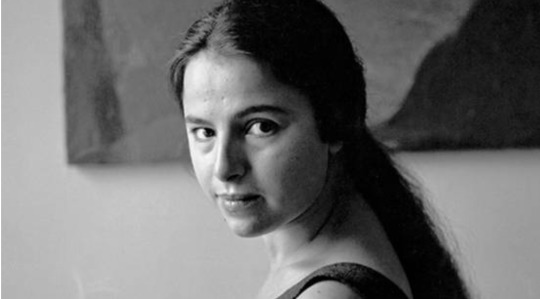
Eve Hesse (January 11, 1936 – May 29, 1970) was a German-born American sculptor known for her pioneering work in materials such as latex, fibreglass, and plastics. She is one of the artists who ushered in the postminimal art movement in the 1960s.
Hesse was born into a family of observant jews in Hamurg, Germany, on January 11, 1936. When Hesse was two years old in December 1938, her parents, hoping to flee from Nazi Germany.
After almost six months of separation, the reunited family moved to England and then, in 1939, emigrated to New York City, where they settled into Manhattan’s Washington Heights. In 1944, Hesse's parents separated; her father remarried in 1945 and her mother committed suicide in 1946. In 1962, Hesse met and married sculptor Tom Doyle (1928–2016); they divorced in 1966.
In October 1969, she was diagnosed with a brain tumour, and she died on May 29, 1970, after three failed operations within a year. Her death at the age of 34 ended a career that would become highly influential, despite spanning only a decade.
Her art is often viewed in the context of the many struggles of her life. This includes escaping from the Nazis, her parents' divorce, the suicide of her mother when she was 10, her failed marriage, and the death of her father. A 2016 documentary entitled Eva Hesse, premiered in New York, illustrated her painful background.
While experiences no doubt had profound impressions on Hesse, the true impact of her artwork has been her formal, artistic invention: for example, her inventive uses of material, her contemporary response to the minimalist movement, and her ability to usher in the postmodern and postminimalist art movements.
Hesse was among the first artists of the 1960s to experiment with the fluid contours of the organic world of nature, as well as the simplest of artistic gestures. Some observers see in these qualities latent, proto-feminist references to the female body; others find in Hesse's languid forms expressions of wit, whimsy, and a sense of spontaneous invention with casually found, or "everyday" materials. Prominent artists that have noted her as a primary influence include Japanese artist Eiji Sumi.
1 note
·
View note
Text
Eva Hesse

Eva Hesse was a German-born American sculptor known for her pioneering work in materials such as latex, fiberglass, and plastics. She is one of the artists who ushered in the postminimal art movement in the 1960s
1936-1970

Hang Up
Eva Hesse
Date: 1966
Style: Conceptual Art, Post-Minimalism
canvas with protruding iron rod
________________________________________________________

Metronomic Irregularity I
Eva Hesse
Date: 1966
Germany
Material: painted wood, metal, cotton, wire
Measurements12"x18"x1"
__________________________________________________

Metronomic Irregularity II
Eva Hesse
Date: 1966
Style: Post-Minimalism
wall installation with twisted fibers
______________________________________________________

Right After
Eva Hesse
Date: 1969
Germany
Material: fiberglass over string
Measurements6.5x10x16'
______________________________________________

Untitled or Not Yet
Eva Hesse
Date:1966
Material: net bags, clear polyethylene sheeting, paper, metal weights, and string
Measurements: 71 in. x 15 1/2 in. x 8 1/4 in.

______________________________________

Accession IV
1968
galvanized steel and rubber tubing,
20.6 x 20.3 x 20.9 cm
Ethelyn and Lester Honig, New York.

1 note
·
View note
Photo

Eva Hesse (January 11, 1936 – May 29, 1970) was a German-born American sculptor known for her pioneering work in materials such as latex, fiberglass, and plastics. She is one of the artists who ushered in the postminimal art movement in the 1960s.
2 notes
·
View notes
Text
Hesse, Eva

Artist Webpage/References: http://www.artnet.com/artists/eva-hesse/
https://www.artsy.net/article/artsy-editorial-transformative-career-eva-hesse
https://en.wikipedia.org/wiki/Eva_Hesse
Eva Hesse (January 11, 1936 – May 29, 1970) was a German-born American sculptor known for her pioneering work in materials such as latex, fiberglass, and plastics. She is one of the artists who ushered in the postminimal art movement in the 1960s.


#Yale University studied with Josef Albers at Yale Cooper Union Pratt Institute Art Students League of New York#female#german#american#usa#eeuu#sculpture#installation#Postminimalism
1 note
·
View note
Text
0p civilization beyond earth wallpapers

Gwion Gwion rock paintings found in the north-west Kimberley region of Western Australia c. They may be the result of a basic need of expression that is innate to human beings, or they could have been for the transmission of practical information. Prehistoric artists may have painted animals to "catch" their soul or spirit in order to hunt them more easily or the paintings may represent an animistic vision and homage to surrounding nature. Various conjectures have been made as to the meaning these paintings had to the people that made them. There are examples of cave paintings all over the world-in Indonesia, France, India, Spain, Southern Africa, China, Australia etc. And more recently, in 2021, cave art of a pig found in an Indonesian island, and dated to over 45,500 years, has been reported. The finding was noted to be "the oldest pictorial record of storytelling and the earliest figurative artwork in the world". In December 2019, however, figurative cave paintings depicting pig hunting in the Maros-Pangkep karst in Sulawesi were estimated to be even older, at least 43,900 years old. In November 2018, scientists reported the discovery of the then-oldest known figurative art painting, over 40,000 (perhaps as old as 52,000) years old, of an unknown animal, in the cave of Lubang Jeriji Saléh on the Indonesian island of Borneo ( Kalimantan). The oldest type of cave paintings are hand stencils and simple geometric shapes the oldest undisputed examples of figurative cave paintings are somewhat younger, close to 35,000 years old. The oldest known paintings are approximately 40,000 years old, found in both the Franco-Cantabrian region in western Europe, and in the caves in the district of Maros ( Sulawesi, Indonesia). Pettakere Cave are more than 44,000 years old, Maros, South Sulawesi, Indonesia 3.6.17 Contemporary painting into the 21st century.3.6.15 Hard-edge painting, minimalism, postminimalism, monochrome painting.3.6.14 Washington Color School, Shaped Canvas, Abstract Illusionism, Lyrical Abstraction.3.6.13 New abstraction from the 1950s through the 1980s.3.6.12 Art brut, New Realism, Bay Area Figurative Movement, neo-Dada, photorealism.3.6.11 Figurative, landscape, still-Life, seascape, and Realism.3.6 20th-century modern and contemporary.3.5 19th century: Neo-classicism, History painting, Romanticism, Impressionism, Post-Impressionism, Symbolism.The 19th century saw the rise of the commercial art gallery, which provided patronage in the 20th century. Finally in the West the idea of " art for art's sake" began to find expression in the work of the Romantic painters like Francisco de Goya, John Constable, and J. Beginning with the Baroque era artists received private commissions from a more educated and prosperous middle class. From the Modern era, the Middle Ages through the Renaissance painters worked for the church and a wealthy aristocracy. Initially serving utilitarian purpose, followed by imperial, private, civic, and religious patronage, Eastern and Western painting later found audiences in the aristocracy and the middle class. African art, Jewish art, Islamic art, Indonesian art, Indian art, Chinese art, and Japanese art each had significant influence on Western art, and vice versa. Until the early 20th century it relied primarily on representational, religious and classical motifs, after which time more purely abstract and conceptual approaches gained favor.ĭevelopments in Eastern painting historically parallel those in Western painting, in general, a few centuries earlier. Across cultures, continents, and millennia, the history of painting consists of an ongoing river of creativity that continues into the 21st century. It represents a continuous, though periodically disrupted, tradition from Antiquity. The history of painting reaches back in time to artifacts and artwork created by pre-historic artists, and spans all cultures.

0 notes
Photo
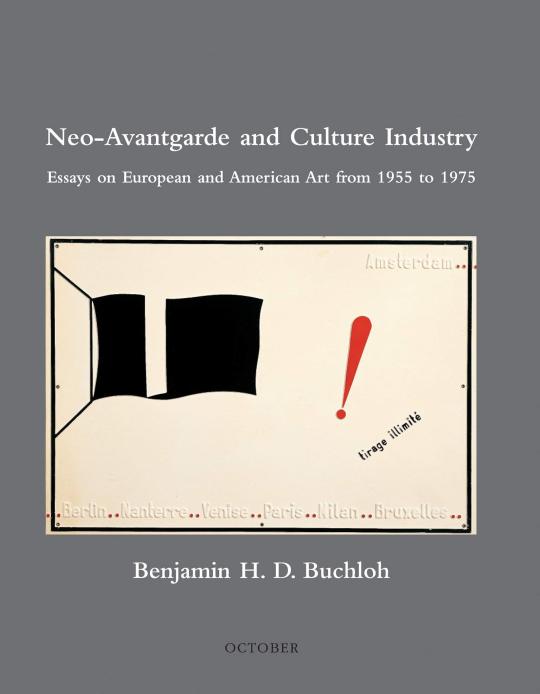
Neo-Avantgarde and Culture Industry
Benjamin H.D. Buchloh
Some critics view the postwar avant-garde as the empty recycling of forms and strategies from the first two decades of the twentieth century. Others view it, more positively, as a new articulation of the specific conditions of cultural production in the postwar period. Benjamin Buchloh, one of the most insightful art critics and theoreticians of recent decades, argues for a dialectical approach to these positions.This collection contains eighteen essays written by Buchloh over the last twenty years. Each looks at a single artist within the framework of specific theoretical and historical questions. The art movements covered include Nouveau Realisme in France (Arman, Yves Klein, Jacques de la Villegle) art in postwar Germany (Joseph Beuys, Sigmar Polke, Gerhard Richter), American Fluxus and pop art (Robert Watts and Andy Warhol), minimalism and postminimal art (Michael Asher and Richard Serra), and European and American conceptual art (Daniel Buren, Dan Graham). Buchloh addresses some artists in terms of their oppositional approaches to language and painting, for example, Nancy Spero and Lawrence Weiner. About others, he asks more general questions concerning the development of models of institutional critique (Hans Haacke) and the theorization of the museum (Marcel Broodthaers); or he addresses the formation of historical memory in postconceptual art (James Coleman). One of the book's strengths is its systematic, interconnected account of the key issues of American and European artistic practice during two decades of postwar art. Another is Buchloh's method, which integrates formalist and socio-historical approaches specific to each subject.
0 notes
Text

Eva Hesse
was a German-born American sculptor
Material: latex, fiberglass, and plastics. 
postminimal art movement
1 note
·
View note
Photo

Continuous and Related Activities: Discontinued by the Act of Dropping, Barry Le Va
#sculpture#sculptor#installation#art installation#installation art#contemporary art#art contemporain#process art#postminimal art movement#postminimal#post minimal#postminimalism#minimalism#minimalist#artwork#art piece#art#artsy#arty#art of the day#art daily#daily art#inspiration#inspirational#inspire
2 notes
·
View notes
Photo

Eva Hesse (1936 – 1970), was a Jewish German-born American sculptor, known for her pioneering work in materials such as latex, fiberglass, and plastics. She is one of the artists who ushered in the postminimal art movement in the 1960s.
Hesse was born into a family of observant Jews in Hamburg. When Hesse was two years old in December 1938, her parents, hoping to flee from Nazi Germany, sent Hesse and her older sister, Helen Hesse Charash, to the Netherlands via Kindertransport.After almost six months of separation, the reunited family moved to England and then, in 1939, emigrated to New York City, where they settled into Manhattan's Washington Heights. In 1944, Hesse's parents separated; her father remarried in 1945 and her mother committed suicide in 1946.
In 1969, she was diagnosed with a brain tumor, and she died in 1970, at the age of 34. Her art is often viewed in light of all the painful struggles of her life including escaping the Nazis, her parents' divorce, the suicide of her mother when she was 10, her failed marriage, and the death of her father. While experiences no doubt had profound impressions on Hesse, the true impact of her artwork is in her inventive uses of material, her incredibly contemporary response to the minimalist movement, and her ability to usher in the postmodern and postminimalist art movements.
Danto describes her as "cop[ing] with emotional chaos by reinventing sculpture through aesthetic insubordination, playing with worthless material amid the industrial ruins of a defeated nation that, only two decades earlier, would have murdered her without a second thought."
In 2016, a documentary titled Eva Hesse, premiered in New York directed by Marcie Begleiter. (mostly from wikipedia)
16 notes
·
View notes
Text


HAPPY BIRTHDAY RICHARD TUTTLE!
“Richard Tuttle has revolutionized the landscape of contemporary art, challenging rules and notions of genre and media.
His work exceeds rational determinations, sensitizing viewers to perception and the unconscious, and engages aspects of painting, drawing, sculpture, bookmaking, printmaking, and installation.
Exposed to the Pop movement and the beginnings of Minimalism as a young artist, Tuttle began to explore the possibilities of material and form freed from historical allusion and precedent. Early investigations into the merging of painting and sculpture are evident in his Constructed paintings which exist in a liminal space between mediums. For Tuttle, the 1980s and 1990s marked wider experimentation with material and a move toward in-the-round constructions. He began incorporating the frame as an element in his compositions, collapsing the boundaries between the artwork and its surrounding space.Tuttle’s engagement with scale, light, and systems of display have endured throughout his oeuvre and can be seen in his attention to marginal spaces such as floors, corners, and over door frames. Rejecting the rationality and precision of Minimalism, Tuttle embraced a handmade quality and the invention of forms that emphasize the occupation of these space along with volume. Over the course of his career, he has continued to overturn traditional constraints of material, medium, and method that engages a variety of traditional and non-traditional processes such as in his wire, small-scale collage, dyed cloth, and octagonal pieces.Richard Tuttle draws beauty and poetry out of humble materials, creating works that exist in the present moment, reflect the fragility of the world, and allow for individual experiences of perception.”
PACE Gallery
“New Mexico, New York #14” 1998,
Is seen hanging over a Donald Judd partners Desk in alanine dyed Finnish plywood, in a NYC apartment. The desk and chairs are now in the collection of the @risdmuseum
#richardtuttle #postminimalism #glenngisslerdesign #artadvisor #interiordesignalchemy #donaldjudd
0 notes